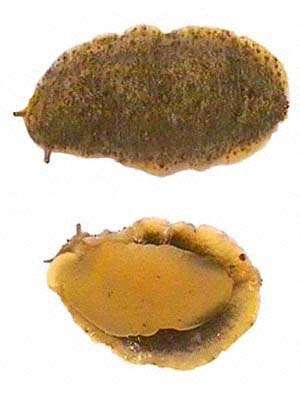
Marine Pulmonate slugs
Order: Systellommatophora
Family: Onchidiidae
DISTRIBUTION
Worldwide, intertidal.
PHOTO
Onchidium damelii, a common onchidiid in mangrove swamps in New South Wales, Australia, where it is found in large numbers on the mudflats. Length 35mm.
PHOTO: Stephanie A. Clark.
The onchidioideans are shell-less slug-like marine molluscs. They range in size from 10-70mm long. They are usually oval in shape with a hard leathery mantle which ranges from smooth in some species to tuberculate in others. Some species have gill-like papillae scattered over the back and in other species there are eye-like sensory structures on the back. These relatives of the land snails have a section of the mantle cavity modified as a lung to breath air. It opens through a pore alongside the posteriorly opening anus, below the mantle.
Onchidiids live intertidally, often in sheltered estuaries on rocks, mud, and in mangrove swamps. They are also found on limestone cliffs with wide raised intertidal limestone platforms. Little has been published on their natural history but it is thought they feed on the organic film of diatoms, other algae, and bacteria which coat rocks and mud on sheltered intertidal shores. Genera include Onchidium, Onchidella, Onchidina and Platevindex.
Authorship detailsRudman, W.B., 1999 (January 13) Marine Pulmonate slugs. [In] Sea Slug Forum. Australian Museum, Sydney. Available from http://www.seaslugforum.net/find/onchid
Related messages
Limpet-like slug from New South Wales
February 22, 2010
From: Sam Rodely
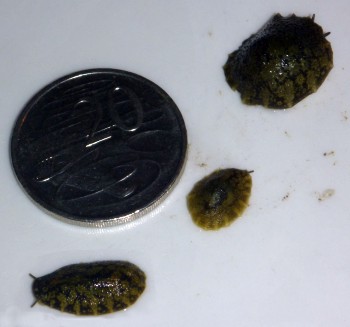
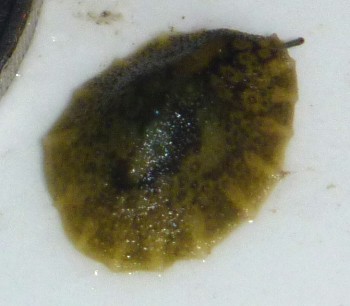
Hi,
I wondered if i could get some help identifying this interesting slug I found while working my family's oyster leases on the NSW far south coast. It seems to be mimicking a limpet, both in shape and pattern.
Locality: Nelson Lagoon, intertidal , NSW, Australia, 10 February 2010, on oyster farm post. Length: smallest 14mm largest 20mm. Photographer: Sam Rodely.
Thanks,
Sam
srodely@gmail.com
Rodely, S.J., 2010 (Feb 22) Limpet-like slug from New South Wales. [Message in] Sea Slug Forum. Australian Museum, Sydney. Available from http://www.seaslugforum.net/find/23233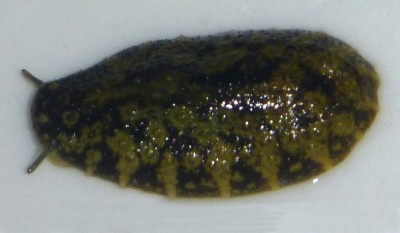
Dear Sam,
These are definitely slugs, and as they live in the sea you would be right to think they are 'seaslugs' but in fact they are much more closely related to land slugs and land snails than they are to opisthobranchs and nudibranchs which we normally called 'sea slugs'.
They belong in the family Onchidiidae, and like land slugs and snails, they have a 'lung' and breathe air. In live animals you will see that like land slugs and snails their eyes are found at the tips of long eye stalks while in true 'sea slugs' the eyes are usually embedded in the skin.
Onchidiids are quite common in intertidal locations and different species are found in mangroves swamps and rocky shores. In some parts of the world they can grow extremely large [up to 70 mm long]. Have a look at the Fact Sheet and older messages attached to it for further information
Best wishes,
Bill Rudman
Re: Onchidella celtica from Channel Ids
July 22, 2008
From: Frans Janssens
Concerning message #20771:
Hi,
Please note that the original ID of the arthropods as Crustacea was not too bad. Recent molecular phylogenies place Collembola more close to basal crustaceans than to insects. Although there is no consensus yet about the exact position of Collembola in Arthropoda.
For an overview, see:
Janssens, F. & Lawrence, P.N. 2002-2008. (in prep.).
Are Collembola terrestrial Crustacea?
http://www.collembola.org/publicat/crustacn.htm
Take care,
Frans Janssens
www.collembola.org
frans.janssens@collembola.org
Janssens, F., 2008 (Jul 22) Re: Onchidella celtica from Channel Ids. [Message in] Sea Slug Forum. Australian Museum, Sydney. Available from http://www.seaslugforum.net/find/21732Dear Frans,
This must be one of the slowest conversations on the Forum. My inadvertent arthropod-crustacea-collembola connection must be a sign that I should have studied arthropod phylogeny! At this stage in my career however, I think I will continue studying animals with one foot and no legs.
Best wishes,
Bill Rudman
Re: Onchidella celtica from Channel Ids
September 22, 2007
From: Jean-Yves Monnat
Concerning message #4806:
Hello,
I agree with the diagnostic about the first picture, but not about the second one. These animals are definitely small insects living in the intertidal zone and named Anurida maritima (Collembola). You can find a lot of other pictures of this animal on Google Imge.
Best regards
Jean-Yves Monnat
Jean-Yves.Monnat@univ-brest.fr
Monnat, J-Y., 2007 (Sep 22) Re: Onchidella celtica from Channel Ids. [Message in] Sea Slug Forum. Australian Museum, Sydney. Available from http://www.seaslugforum.net/find/20771Dear Jean-Yves,
Thanks for that - 5 years to get a correction!. I guess that's why the Forum is a slug site not an arthropod site. My expert opinion was restricted to knowing they were not Onchidella eggs. At least I recognised them as arthropods.
Thanks for bothring to let us know,
Bill Rudman
Pulmonate slugs from the Caribbean
July 4, 2007
From: Phillip Gillette
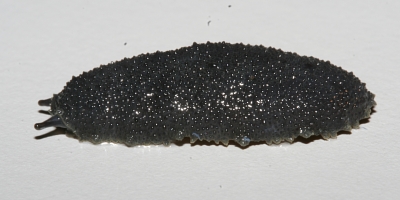
Here's some species of a marine pulmonate I found in Miami, not sure of the genus. I just figured I would post it, since all of the Pulmonate pictures have been from the Indo-Pacific.
Locality: Miami, Florida, USA, Atlantic. Photographer: Phillip Gillette.
Phillip Gillette
pgillette1@hotmail.com
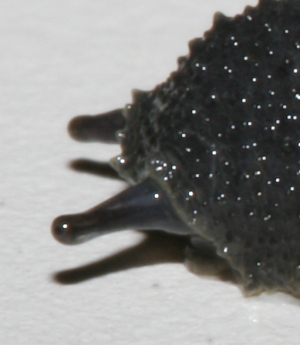
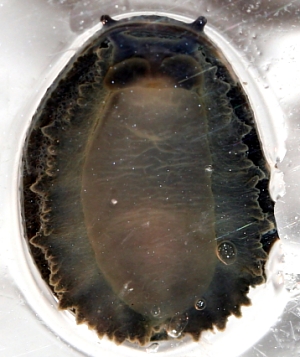
Dear Phillip,
I'm happy to redress the balance. Since its the USA's birthday today I can't have you feeling left out.
Best wishes,
Bill Rudman
Marine pulmonate slug from India
April 4, 2007
From: Doug Eernisse
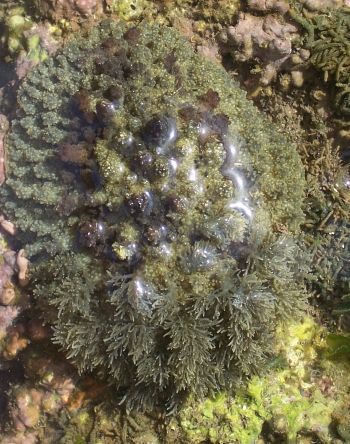
A biologist from India has requested IDs of these two slug species. I work on chitons.
Locality: near Gujarat, India, Arabian Sea, 11 March 2007, intertidal. Approx 65 mm long. Photographer: Dr. Rahul Kundu.
Thanks,
Doug Eernisse.
deernisse@fullerton.edu
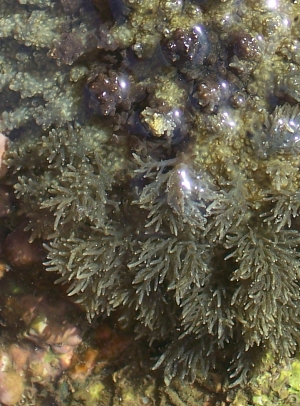
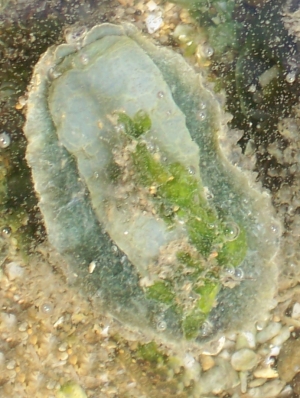
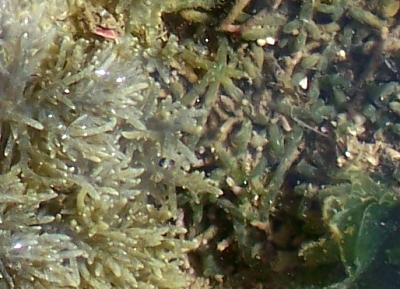
Dear Doug,
I remember finding these myself in the Gulf of Kutch, Gujarat, 35 years ago. This is a remarkable marine pulmonate slug, which looks very much like a nudibranch. The gills on its back certainly look quite dorid-like, but although in this photo they seem to be restricted to the posterior end of the animal, the tubercles all over the dorsum have similar 'gills' inside, just waiting to evert when they are covered with sea water.
Its name is Onchidium verruculatum. Have a look at the Marine Pulmonate Fact Sheet for more information, and at the messages attached to that page, where there are more photos and information. What I find interesting in these photos is just how similar the gills are in shape and size to the matted Valonia-like green algae growing on the rocks alongside. In the close-up photo alongside, the gills are on the left and the algae is on the right. This Onchidium is very difficult to see at low tide, when it looks just like a bit of the limestone rock platform, but its seems that even when covered at high tide, with its gills out, it is almost invisble as well.
Best wishes,
Bill Rudman
Onchidium from the Arabian Sea
November 16, 2006
From: Bhavik Patel
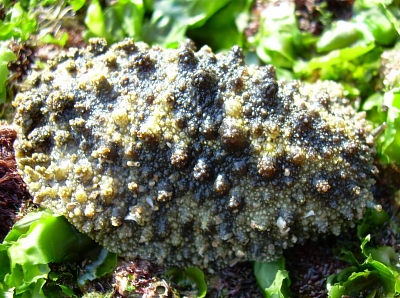
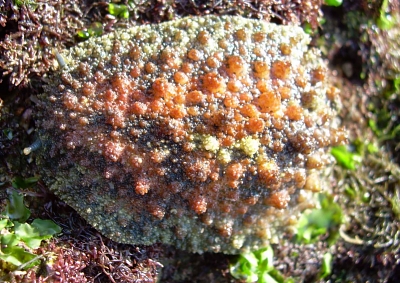
Dear Dr.Bill,
I am working in Bombay Natural History Society (Mumbai) on Marine Mollusca. I last week had been in Vealver (Dist. Junaghad, State. Gujarat, India) which is situated on the coast of Arabian Sea. There I found Sea Slugs thousands in numbers, and many of them were mating. But next day when I went there again for the collection of a few samples, the numbers were only in 100 or 200. Unfortunately I didn't recognise the species. so please help me on this.
Locality: Velaver, Above water level (10-20 cm.), Gujarat, Arabian Sea, 6 November 2006, Rocky Shore with lots of sea weeds. Length: 7-12 cm. Photographer: Bhavik Patel
Bhavik Patel
Project Officer.
Conservation Department.
BNHS.
bhavikedu@yahoo.co.in
Patel, B.K., 2006 (Nov 16) Onchidium from the Arabian Sea. [Message in] Sea Slug Forum. Australian Museum, Sydney. Available from http://www.seaslugforum.net/find/18362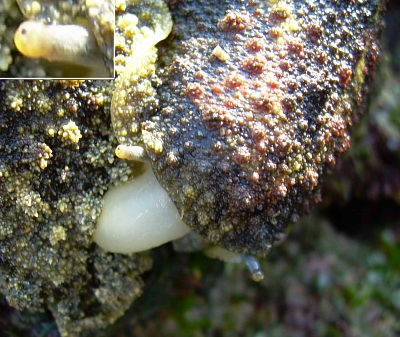
Dear Bhavik,
This is a marine pulmonate of the family Onchidiidae. It is definitely a slug, but its closest relatives are the land slugs not the sea slugs. In the photo alongside you can see a pair of head tentacles, each with a small black eye at the tip. Opisthobranchs don't have stalked eyes like this. I suspect your animal is Onchidium verruculatum, which is a large onchidiid from the Indian Ocean. When it is immersed in water branched gill-like papillae extend from the tubercles on its back and look very much like a nudibranch's gills
The animals you saw may have been mating, but the white structure in your photo alongside is the 'snout' which bears the mouth at its tip. Have a look at the Fact Sheet and attached messages for further information on this group of slugs.
Best wishes,
Bill Rudman
Korean slug in intertidal zone
September 6, 2006
From: William Churchill
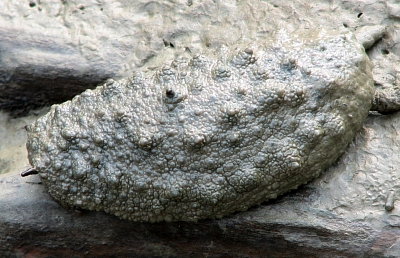
I found this slug in a tidal stream that runs through a reed bed. The bottom is clay, common to the west coast of Korea.
Locality: Incheon, on mud flat 0 meters, Korea, Yellow Sea, 15 Aug 2006, intertidal. Length: 100 mm. Photographer: William Churchill.
William Churchill
deanchurchill1973@hotmail.com
Churchill, W.D, 2006 (Sep 6) Korean slug in intertidal zone. [Message in] Sea Slug Forum. Australian Museum, Sydney. Available from http://www.seaslugforum.net/find/17747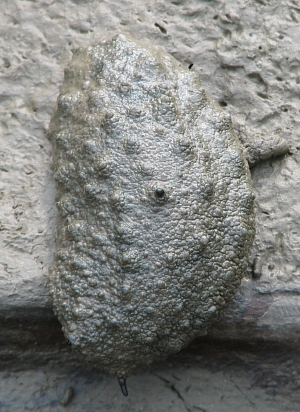
Dear Dean,
This is one of those animals which confounds 'common names'. It is definitely a slug and it is definitely marine, but it is not a 'sea slug'. It is a pulmonate slug rather than an opisthobranch slug [Family Onchidiidae], much more closely related to land snails. Have a look at the Fact Sheet and earlier messages for more information.
Best wishes,
Bill Rudman
Sea slug from Tioman Island, Malaysia
February 16, 2004
From: Andrew Lee
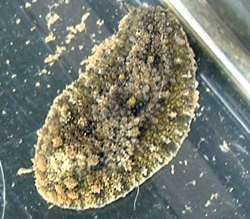
Hi! I collected this sea slug, which I can't identify and was hoping for your expertise. I picked it up from Tioman Island, Malaysia, which is within the Indo-Pacific range. It is quite small in size, slightly less than 2 inches in length. Unfortunately, I can't send a picture now. However, here is the description: its body resembles that of sea slugs from the family Phyllidiidae, and is a mottled army green/brown(the colour of live rock which it was camouflaged with) with a very indistinct grey stripe on its back. The texture of its body is quite like Ricordea mushroom corals with little bumps all over. Some bumps are very prominent with a yellow coloration on the tip. I found it during low tide, clinging to a piece of rock. I think it is an intertidal species as the habitat which it is from is fully submerged during high tide, and completely exposed during low tide. The sand is quite soft and very fine, kind of like silt, and salinity quite low, at about 1.018SG, as it was near the mouth of a stream that flowed into the sea. Andrew Lee
leeyoongchuen@yahoo.com
Lee, A., 2004 (Feb 16) Sea slug from Tioman Island, Malaysia. [Message in] Sea Slug Forum. Australian Museum, Sydney. Available from http://www.seaslugforum.net/find/12119Dear Andrew,
This is indeed a 'slug', and it is found in or near the sea but it is not an opisthobranch sea slug. It is in fact an onchidiid, which are a group of marine pulmonates closely related to land snails. They have a lung-like cavity which allows then to breath both in air and in water. From memory, I think a group in Singapore discovered they had about 10 species living there. They had good anatomical differences, but could only be separated externally on small colour differences.
Best wishes
Bill Rudman
Re: Onchidiid from Thailand
April 28, 2003
From: Kevin J. Caley
We have been calling this animal Onchidium verrucosa, which is uncommon to common in Hong Kong. However, not much work has been done here on this group, so we ARE fumbling in the dark a bit!
Kevin J. Caley
kevin@ecology.hku.hk
Dear Kevin,
The lack of a shell and the often poor descriptions of living animals, means the onchidiids are in a taxonomic mess. Fortunately, internal anatomy seems to be quite distinctive so it should be possible to sort them out although it may mean consigning many older names to an 'unidentifiable' list. There are similar problems with another 'slug' group -the lamellariid section of the velutinids, but in that case many species were described from the reduced internal shell alone so now it is a question of matching shells with living bodies.
Returning to Onchidium. Onchidium verruculatum is a large Indian Ocean species with secondary gills on its back. I agree that the literature is sparse but Cuvier's original description makes it pretty certain that this large species with seondary gills on the mantle is quite identifiable. Unfortunately later authors have incorrectly identified other species from both the Pacific and the Indian Ocean as O. verruculatum and O. verrucosa [See photo below]. I am not sure that this species is the same - it is certainly large enough, but I can see no sign of the secondary gills.
Best wishes,
Bill Rudman
Dendrodoris? from Siladen, Indonesia
December 3, 2002
From: Ginette Allard
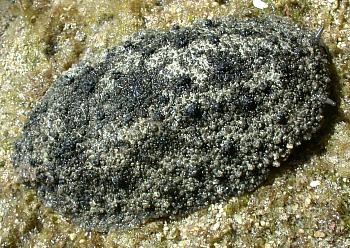
Dear Bill,
Is this a Dendrodoris?
Data: Siladen Beach (Indonesia ) at low tide, in the sun. 8 to 10 cm. No gills on the back.
Ginette Allard
gigiallard@aol.com
Allard, G., 2002 (Dec 3) Dendrodoris? from Siladen, Indonesia. [Message in] Sea Slug Forum. Australian Museum, Sydney. Available from http://www.seaslugforum.net/find/8490Dear Ginette,
Sitting in the sun at low tide is a sign that this is not a nudibranch. It is in fact an onchidiid, which are a group of marine pulmonates closely related to land snails. They have a lung-like cavity which allows then to breath both in air and in water.
Best wishes
Bill Rudman
Re: Onchidella celtica from Channel Ids
February 18, 2002
From: Yves Muller
Dear Bill,
The litle arthropoda on the second picture from Nick Jouault are Collembola as Peter Wirtz wrote In Britain we can found Anurida maritima (Guerin)(fig 9.4.H p 472 in Hayward & Ryland 1995 Handbook of the Marine Fauna of North-West Europe). In Barrett & Yonge 1958 (Collins Pocket Guide to the Sea Shore) p121 we can read: " Body soft-blue, perhaps 1/8 in. long; usually on surface film of rock pools especially where these are small and very sheltered. Upper half of shore, often in groups together; also moving on rocks and weeds. Widely distributed. Common --> Lipura maritima (= Anurida maritima").
But we are very far from sea-slugs.
Best regards
Yves Müller
41, rue André Chênier
59240 DUNKERQUE
FRANCE
ymuller@netinfo.fr
Müller, Y., 2002 (Feb 18) Re: Onchidella celtica from Channel Ids. [Message in] Sea Slug Forum. Australian Museum, Sydney. Available from http://www.seaslugforum.net/find/6292Dear Yves,
Thanks for this. As you say we are indeed a long way from sea slugs.
Best wishes,
Bill Rudman
Re: Onchidella 'eggs'
February 17, 2002
From: Peter Wirtz
Dear Bill,
Surely the 'eggs' are Collembola !
Cheers,
Peter
biomar@dragoeiro.uma.pt
Wirtz, P., 2002 (Feb 17) Re: Onchidella 'eggs'. [Message in] Sea Slug Forum. Australian Museum, Sydney. Available from http://www.seaslugforum.net/find/6272Dear Peter,
I didn't think of Collembola as marine animals, but that could be why they are floating on the water surface. The point I was trying to make was that they weren't eggs and were probably arthropods.
Cheers,
Bill Rudman
Onchidella celtica from Channel Ids
February 11, 2002
From: Nick Jouault
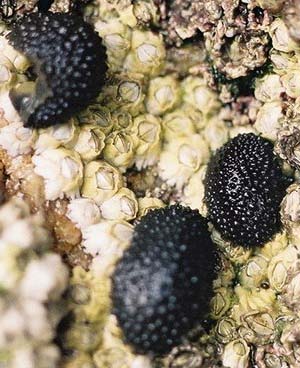
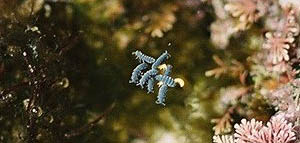
I have seen what I think is Onchidella celtica over the the last two weeks of July at Bigorne, Les Ecrehous, Jersey, Channel Islands. Is it Onchidella celtica, and is the other picture its spawn. Any info on this would be appreciated.
Nick
jouault@hotmail.com
Jouault, N., 2002 (Feb 11) Onchidella celtica from Channel Ids. [Message in] Sea Slug Forum. Australian Museum, Sydney. Available from http://www.seaslugforum.net/find/4806Dear Nick,
Yes I think this is Onchidella celtica. Although marine, and a 'slug' it is not an opisthobranch sea slug, but rather a pulmonate land slug, closely related to most land snails. I have a page on this group as they are quite often asked about. Concerning your second photo. I am pretty sure the egg mass of Onchidella celtica will be fairly typical of the group, consisting of a jelly-like ribbon with a string of tiny eggs embedded in it. The objects in your photos look like a group of isopod crustacea.
Best wishes,
Bill Rudman.
Giant Onchidium from South Africa
May 8, 2001
From: Valda Fraser
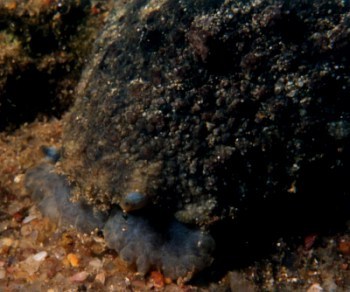
Dear Bill
An amazing animal! I found it crawling right out of the water on a rock in the intertidal zone. I was so worried about it that I popped it into the pool. This was not the right thing to do because it immediately crawled out again. I am sending you two photos - the anterior [upper photo]and posterior [loer photos] ends.
Locality: Pumula, south coast KwaZulu-Natal, SOUTH AFRICA, intertidal zone
Date: April 2001
Size: 10 cm
Regards
Valda
valdafraser@mweb.co.za
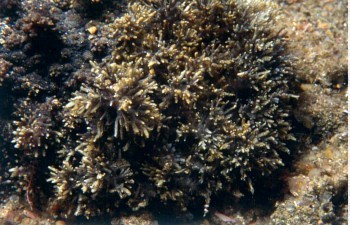
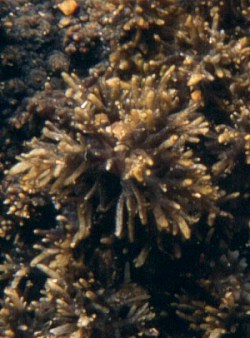
Dear Valda,
This is a Pulmonate Slug. While many live in mangrove environments, this very large species, Onchidium verruculatum Cuvier, 1803, is common on rocky shores in many parts of the Indian Ocean. It hides in crevices at high tide emerging at low tide to graze over rocks. Studies show that it follows a mucous trail home after each feeding 'expedition'. I remember, in northwestern India, where I saw these animals alive for the first time, wondering what these large warty dorids were doing so high on the shore. As you can see in the bottom right photo, they have remarkable gill-like branching papillae over the posterior half of their backs, and it is only on picking them up that their pulmonate anatomy becomes obvious.
McFarlane, I.D. (1981) In the intertidal homing gastropod Onchidium verruculatum (Cuv) the outward and homeward trails have a different information content. J. exp. mar. Biol. Ecol, 51: 207-218
Best wishes,
Bill Rudman
Pulmonate slug? from Maldives
May 4, 2001
From: Erwin Koehler
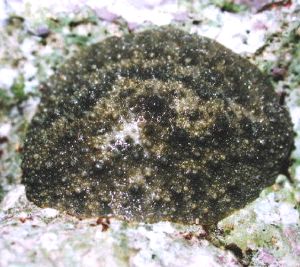
Dear Bill,
Attached is a photo from the Maldives, Nov. 1996. Are they pulmonate slugs?
There were hundreds of them crawling upon the breakwaters at Ellaidhoo island, most of the time not beneath the waterline...and never seen during diving! Max. seen length 7cm.
Erwin
Erwin@medslugs.de
Koehler, E., 2001 (May 4) Pulmonate slug? from Maldives. [Message in] Sea Slug Forum. Australian Museum, Sydney. Available from http://www.seaslugforum.net/find/4262Dear Erwin,
Yes they are a species of the pulmonate air-breathing family Onchidiidae. These animals are definitely restricted to the upper intertidal.
Bill Rudman
Onchidiid from Thailand
March 17, 2001
From: Sylvain Le Bris
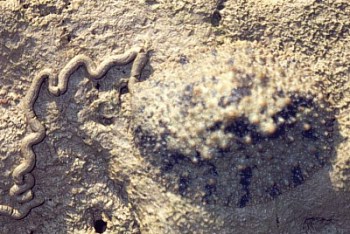
Dear Bill
I am sorry but my english is no good ! And my picture is not good too...
This species was found at Phuket Is. (Andaman Sea, Thailand) and Sichang Is. (Inner Gulf of Thailand) in the low tide, out of water ! This species is abundant and crawls on the rocks when the sun is shining and the temperature is very hot. At high tide, this species stays under rocks without moving.
It was about 6-7 cms long and 2-3 cms wide.
Could you please identify this species ?
Thanks
Sylvain
sylvain.lebris@freesbee.fr
Le Bris, S., 2001 (Mar 17) Onchidiid from Thailand. [Message in] Sea Slug Forum. Australian Museum, Sydney. Available from http://www.seaslugforum.net/find/3988Dear Sylvain,
This is a Pulmonate Slug, related to land snails rather than a Sea Slug. Its mantle cavity has become an internal lung which enables it to live and breathe out of water. I am not sure what genus this species belongs to and I think the genera can only be separated by looking at their anatomy. As you can see from its long faecal string, it feeds on the algal/bacterial film which forms a layer over muddy intertidal surfaces.
Best wishes,
Bill Rudman.
Pulmonate Slugs from Philippines
January 13, 1999
From: Erwin Koehler
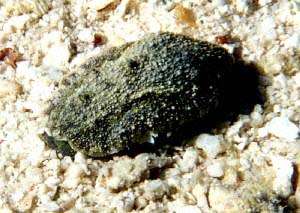
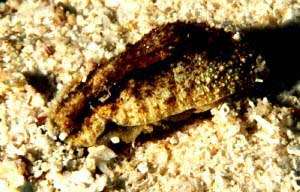
Dear Bill,
Here are the last sea slugs of my trip to the Philippines. The shots were made at BBC, Panglao Is., Nov. 1998 but that is not the place I found them. Some fishermen told to a guest that there are hundreds of sea slugs at the shore at Kalipayan - only at low tide. The guest told it to a dive-guide, this guy told it to me and I walked to Kalipayan (the next settlement)to have a look. I was a little bit late, low tide had passed.
There were many of them, not hundreds but many. Unfortunately my camera did not work because of the humidity. So I couldn't take of them within the original surrounding. They had a strange behaviour: At low tide, when the shore and the plants (which looked like very small Neptune grass in the Mediterranean) ran dry they crawled upon the shore. The sun was burning mercyless - but it seemed as if they didn't mind. I put one of them in the warm water of a very shallow tidepool (depth about 10 cm) and it crawled into the sand. I guess they usually live underneath the sand. I decided to take 5 of them with me to get some shots during the next dive. The reeftop at BBC has a similar surrounding (sand with plants) but it does not run dry at low tide.
There happened the same: All of them crawled into the sand, 3 minutes later no one was left visible. Do you have any idea about the ID and their behaviour (crawling in the sun)? Perhaps a need of oxygen?
Excuse my Germenglish, I hope you can understand what I tried to say.
Erwin
E.Koehler@deutschepost.de
Koehler, E., 1999 (Jan 13) Pulmonate Slugs from Philippines. [Message in] Sea Slug Forum. Australian Museum, Sydney. Available from http://www.seaslugforum.net/find/461Dear Erwin,
There's nothing wrong with your Germenglish..and its a lot better than my German!
The reason your animals were doing silly things like crawling in the sun and out of the water is that they are pulmonate (ari-breathing)land slugs. Yet another group of snails that have lost their shells. There are a number of pulmonate land snails that live in the marine intertidal. Apart from the onchidiids there are the pulmonate limpets (Siphonariidae) and the ellobiid snails.
Often onchidiids do occur in very large numbers. I suspect the ones you took back to photograph and which crawled into the sand, were in fact looking for a solid base on which to crawl. They do not normally crawl on coral sand preferring a hard surface. There are some species which live on mudflats which do crawl on the mud but in those cases the mud is compacted and relatively solid.
Thanks for sharing some of your Philippines finds with us. If you have a few that you could identify without help that you would like to share they would be welcome.
Bill Rudman.
Rudman, W.B., 1999 (Jan 13). Comment on Pulmonate Slugs from Philippines by Erwin Koehler. [Message in] Sea Slug Forum. Australian Museum, Sydney. Available from http://www.seaslugforum.net/find/461Photo of Onchidium
January 13, 1999
From: Stephanie A. Clark
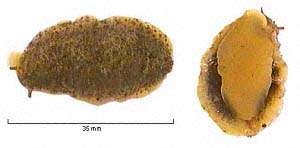
Dear Bill,
You might like to use this photo I have taken of the common New South Wales species Onchidium damelii. It is common in mangroves where it lives on the mud. This specimen was 35mm long.
Stephanie.
inverte@internet-australia.com
Clark, S.A., 1999 (Jan 13) Photo of Onchidium. [Message in] Sea Slug Forum. Australian Museum, Sydney. Available from http://www.seaslugforum.net/find/464Thanks very much Stephanie. Your two photos certainly show the main characters of these marine pulmonate slugs. I have added them to the top of the page.
Bill Rudman.
